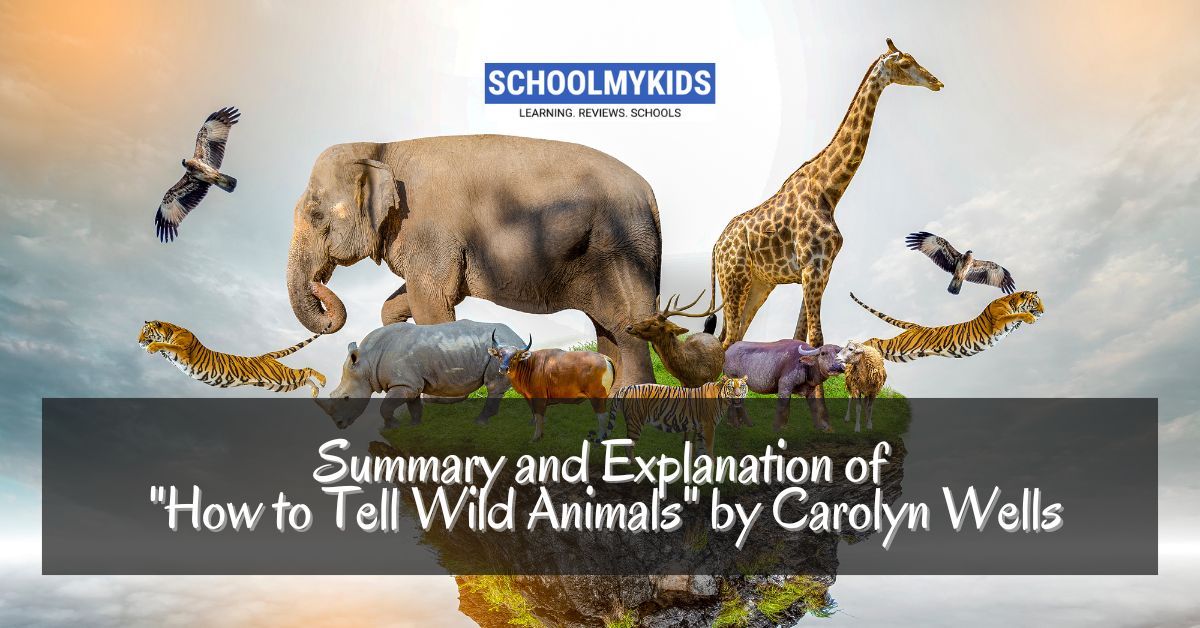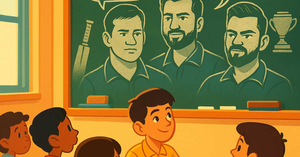“How to Tell Wild Animals” is a poem from the Class 10 CBSE English textbook, “First Flight.”
Summary
“How to Tell Wild Animals” is a humorous poem by Carolyn Wells that describes various wild animals in a playful and entertaining manner. The poet provides amusing guidelines on how to identify different animals, using exaggerated and comical descriptions. The poem is structured in a series of stanzas, each focusing on a different animal.
- The Asian Lion: The poet suggests that if you are in the jungle and an animal roars loudly enough to terrify you to death, it is likely an Asian lion.
- The Bengal Tiger: If you see a creature with black stripes and it suddenly attacks you, it is probably a Bengal tiger.
- The Leopard: You can identify a leopard if it leaps at you and tears you apart, with its distinctive spots being a key feature.
- The Bear: If you encounter a beast that hugs you tightly, it is likely a bear.
- The Crocodile: The poet humorously notes that if you see tears while being eaten, it is a crocodile, referring to “crocodile tears.”
- The Hyena and the Chameleon: The poem concludes with the hyena, which laughs hysterically, and the chameleon, which changes its color to blend with its surroundings.
Explanation:
The poem is a delightful exploration of wild animals through a blend of humor and rhyme. Carolyn Wells uses vivid and exaggerated imagery to create a memorable and amusing experience for the reader. The playful tone and rhythm make the descriptions engaging and easy to remember.
Important Words and Phrases:
- Roar: Describes the loud, frightening sound made by the Asian lion.
- Stripes: Refers to the distinctive black stripes on the Bengal tiger.
- Leaps: Describes the sudden attack of the leopard.
- Hugs: Refers to the tight embrace of the bear, which is ironically deadly.
- Crocodile tears: A phrase that means fake tears, used here to describe the crocodile’s deceptive nature.
- Laughs: Refers to the hyena’s characteristic sound, which resembles laughter.
- Chameleon: A reptile known for changing its color to match its surroundings.
Detailed Summary:
Stanza 1: The Asian Lion
- The poet describes the Asian lion’s roar as loud and terrifying. The roar is so powerful that it can scare a person to death. The roar is the key identifier.
Stanza 2: The Bengal Tiger
- The Bengal tiger is recognized by its black stripes. The poet humorously adds that if the tiger attacks and eats you, you can be sure it is a Bengal tiger.
Stanza 3: The Leopard
- The leopard is identified by its spots. The poet adds that if a leopard leaps at you and tears you apart, the spots confirm it is indeed a leopard.
Stanza 4: The Bear
- The bear is known for its deadly hug. The poet describes a bear’s embrace as tight and lethal, using irony to convey the danger.
Stanza 5: The Crocodile
- The crocodile is identified by its tears. The poet refers to “crocodile tears,” which are insincere, indicating the crocodile’s deceptive nature.
Stanza 6: The Hyena and the Chameleon
- The hyena is recognized by its laughter, which sounds like a hysterical laugh. The chameleon is noted for its ability to change color to match its surroundings.
Themes and Literary Devices
The poem uses humor, irony, and exaggeration to make the descriptions of wild animals entertaining. The rhyme scheme and rhythm add to the playful tone. The poet cleverly uses common phrases like “crocodile tears” to create a connection with the reader’s prior knowledge.
Conclusion
“How to Tell Wild Animals” is an enjoyable and witty poem that provides humorous descriptions of various wild animals. Through its playful language and vivid imagery, it captures the reader’s imagination and offers a lighthearted take on the often dangerous world of wild animals.
Questions and Answers
1. What is the main theme of the poem “How to Tell Wild Animals”?
- Answer: The main theme of the poem is the humorous and exaggerated identification of wild animals, providing a lighthearted take on the often dangerous characteristics of these creatures.
2. How does the poet describe the roar of the Asian lion?
- Answer: The poet describes the roar of the Asian lion as loud and terrifying, powerful enough to scare a person to death.
3. According to the poem, what characteristic helps to identify a Bengal tiger?
- Answer: The Bengal tiger is identified by its black stripes and the poet humorously adds that it will attack and eat you, confirming its identity.
4. What does the poet suggest about the leopard’s behavior?
- Answer: The poet suggests that a leopard will leap at you and tear you apart, and its distinctive spots help identify it.
5. How does the poet ironically describe the bear’s hug?
- Answer: The poet ironically describes the bear’s hug as tight and deadly, using humor to highlight the danger of the bear’s embrace.
6. What does the phrase “crocodile tears” refer to in the poem?
- Answer: In the poem, “crocodile tears” refer to the fake, insincere tears of the crocodile, indicating its deceptive nature.
7. How can you tell a hyena apart from other animals according to the poem?
- Answer: According to the poem, you can tell a hyena apart by its hysterical laughter, which is a characteristic sound it makes.
8. What unique ability of the chameleon does the poet mention?
- Answer: The poet mentions the chameleon’s unique ability to change its color to match its surroundings.
9. What literary devices does Carolyn Wells use in the poem?
- Answer: Carolyn Wells uses humor, irony, exaggeration, rhyme, and vivid imagery to create a playful and entertaining description of wild animals.
10. What is the tone of the poem “How to Tell Wild Animals”?
- Answer: The tone of the poem is humorous, playful, and lighthearted, as it uses exaggerated descriptions and irony to entertain the reader.








Be the first one to comment on this story.